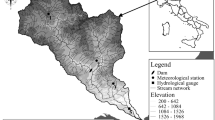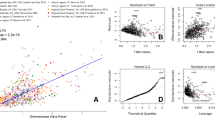Abstract
Warmer climatic conditions have been associated with numerous hydrologic changes that may impact riverbank erosion in cold regions, but the net effect is not well understood. We used regression and correlation analyses to examine the relationships among subarctic riverbank erosion and seasonal hydrology, the impact of climate change and variability, and the societal implications. Geomorphic change (loss and gain of vegetated land) was mapped along several river reaches in the Yukon River Basin, Alaska, throughout 1984 and 2017 using Landsat satellite imagery. Annual erosion rates were estimated from these spatial data. At most study sites, erosion rates (km2/year) were either positively correlated (r = 0.68–0.84, p = 0.0085–0.061) with monthly mean discharge within the cold season or inversely correlated (r = − 0.74 – −0.62, p < 0.10) with river ice breakup date in the spring. These proximate controls on erosion, in turn, were influenced both by climate variability and long-term climatic change. We conclude that increased cold season discharge and earlier freshet that occurs under warmer conditions enhance riverbank erosion in most areas. Climate-related changes to fluvial dynamics may impact communities through effects on infrastructure, travel safety, channel navigability, fish and wildlife habitat, and access to subsistence resources.









Similar content being viewed by others
References
Alaska Native Tribal Health Consortium (2016) Community observations on climate change - Arctic Village, Fort Yukon and Venetie, Alaska. Alaska Native Tribal Health Consortium, Anchorage, Alaska
Arguez A, Durre I, Applequist S, Squires M, Vose R, Yin X, Bilotta R (2010) NOAA’s U.S. Climate Normals (1981-2010). https://doi.org/10.7289/V5PN93JP
Beltaos S (2003) Threshold between mechanical and thermal breakup of river ice cover. Cold Reg Sci Technol 37:1–13. https://doi.org/10.1016/s0165-232x(03)00010-7
Bieniek PA, Bhatt US, Rundquist LA, Lindsey SD, Zhang X, Thoman RL (2011) Large-scale climate controls of interior Alaska river ice breakup. J Clim 24:286–297. https://doi.org/10.1175/2010jcli3809.1
Bieniek PA, Walsh JE, Thoman RL, Bhatt US (2014) Using climate divisions to analyze variations and trends in Alaska temperature and precipitation. J Clim 27:2800–2818. https://doi.org/10.1175/jcli-d-13-00342.1
Bisson PA et al (1987) Large woody debris in forested streams in the Pacific Northwest: past, present, and future. In: Salo EO, Cundy TW (eds) Streamside management: forestry and fishery interactions. University of Washington Press, Seattle, pp 143–190
Bonsal BR, Prowse TD, Duguay CR, Lacroix MP (2006) Impacts of large-scale teleconnections on freshwater-ice break/freeze-up dates over Canada. J Hydrol 330:340–353. https://doi.org/10.1016/j.jhydrol.2006.03.022
Brabets TP, Walvoord MA (2009) Trends in streamflow in the Yukon River Basin from 1944 to 2005 and the influence of the Pacific Decadal Oscillation. J Hydrol 371:108–119. https://doi.org/10.1016/j.jhydrol.2009.03.018
Brabets TP, Wang B, Meade RH (2000) Environmental and hydrologic overview of the Yukon River basin, Alaska and Canada
Brinkman TJ, Hansen WD, Chapin FS, Kofinas G, BurnSilver S, Rupp TS (2016) Arctic communities perceive climate impacts on access as a critical challenge to availability of subsistence resources. Clim Chang 139:413–427. https://doi.org/10.1007/s10584-016-1819-6
Brown DRN (2019) ABoVE: riverbank erosion and vegetation changes, Yukon River Basin, Alaska, 1984-2017. ORNL DAAC, Oak Ridge, Tennessee, USA. https://doi.org/10.3334/ORNLDAAC/1616
Brown DRN, Brinkman TJ, Verbyla DL, Brown CL, Cold HS, Hollingsworth TN (2018) Changing river ice seasonality and impacts on interior Alaskan communities. Weather Climate Soc 10:625–640. https://doi.org/10.1175/WCAS-D-17-0101.1
Buffington JM, Montgomery DR (2013) 9.36 Geomorphic classification of rivers. In: Shroder J, Wohl E (eds) Treatise on geomorphology, vol 9. vol Fluvial Geomorphology. Academic Press, San Diego, pp 730–767. https://doi.org/10.1016/b978-0-12-374739-6.00263-3
Butler LG, Kielland K, Rupp ST, Hanley TA (2007) Interactive controls of herbivory and fluvial dynamics on landscape vegetation patterns on the Tanana River floodplain, interior Alaska. J Biogeogr 34:1622–1631
Carlson TN, Ripley DA (1997) On the relation between NDVI, fractional vegetation cover, and leaf area index. Remote Sens Environ 62:241–252. https://doi.org/10.1016/S0034-4257(97)00104-1
Carothers C, Brown C, Moerlein KJ, Lopez JA, Andersen DB, Retherford B (2014) Measuring perceptions of climate change in northern Alaska: pairing ethnography with cultural consensus analysis. Ecol Soc 19:27. https://doi.org/10.5751/ES-06913-190427
Chapin FS III et al (2006) Successional processes in the Alaskan boreal forest. In: Chapin FS III, Oswood MW, Van Cleve K, Viereck LA, Verbyla DL (eds) Alaska’s changing boreal forest. Oxford University Press
Christensen JH et al (2007) Regional climate projections. In: Climate change, 2007: the physical science basis. Contribution of Working group I to the Fourth Assessment Report of the Intergovernmental Panel on Climate Change, University Press, Cambridge, Chapter 11. pp 847–940
Church MA (1971) Northern rivers: consulting report
Clement DT (1999) Fluvial geomorphology of the Yukon River, Yukon Flats, Alaska. University of Calgary
Cold H, Brinkman T, Brown C, Hollingsworth T, Verbyla D, Brown D, Heeringa K (2020) Assessing vulnerability of subsistence travel to effects of environmental change in interior Alaska. Ecol Soc 25:20. https://doi.org/10.5751/ES-11426-250120
Durand JR et al (2011) Environmental heterogeneity and community structure of the Kobuk River, Alaska, in response to climate change. Ecosphere 2:44. https://doi.org/10.1890/es10-00111.1
Eardley AJ (1938) Yukon channel shifting. GSA Bull 49:343–358. https://doi.org/10.1130/gsab-49-343
Ettema R (2002) Review of alluvial-channel responses to river ice. J Cold Reg Eng 16:191–217
Folland C et al (2001) The scientific basis. Climate Change:101–181
Ge S, Yang D, Kane DL (2013) Yukon River Basin long-term (1977-2006) hydrologic and climatic analysis. Hydrol Process 27:2475–2484. https://doi.org/10.1002/hyp.9282
Hartmann B, Wendler G (2005) The significance of the 1976 Pacific climate shift in the climatology of Alaska. J Clim 18:4824–4839
Herman-Mercer N, Schuster PF, Maracle KB (2011) Indigenous observations of climate change in the lower Yukon River Basin, Alaska. Hum Organ 70:244–252
Hooke JM (2008) Temporal variations in fluvial processes on an active meandering river over a 20-year period. Geomorphology 100:3–13. https://doi.org/10.1016/j.geomorph.2007.04.034
IPCC (2013) Climate change 2013: the physical science basis. Contribution of Working Group I to the Fifth Assessment Report of the Intergovernmental Panel on Climate Change. Cambridge University Press, Cambridge, United Kingdom and New York, NY, USA. https://doi.org/10.1017/CBO9781107415324
Johnson I, Brinkman T, Britton K, Kelly J, Hundertmark K, Lake B, Verbyla D (2016) Quantifying rural hunter access in Alaska. Hum Dimens Wildl 21:240–253. https://doi.org/10.1080/10871209.2016.1137109
Kanevskiy M, Shur Y, Strauss J, Jorgenson T, Fortier D, Stephani E, Vasiliev A (2016) Patterns and rates of riverbank erosion involving ice-rich permafrost (yedoma) in northern Alaska. Geomorphology 253:370–384. https://doi.org/10.1016/j.geomorph.2015.10.023
Kramer CY (1956) Extension of multiple range tests to group means with unequal numbers of replications. Biometrics 12:307–310
Larsen EW, Fremier AK, Greco SE (2006) Cumulative effective stream power and bank erosion on the Sacramento River, California, USA. J Am Water Resour Assoc:1077–1097
Larsen PH, Goldsmith S, Smith O, Wilson ML, Strzepek K, Chinowsky P, Saylor B (2008) Estimating future costs for Alaska public infrastructure at risk from climate change. Glob Environ Chang 18:442–457
Lawson DE (1983) Erosion of perennially frozen streambanks. US Army Corps of Engineers, Cold Regions Research and Engineering Lab, Hanover
Lesack LFW, Marsh P, Hicks FE, Forbes DL (2013) Timing, duration, and magnitude of peak annual water-levels during ice breakup in the Mackenzie Delta and the role of river discharge. Water Resour Res 49:8234–8249. https://doi.org/10.1002/2012wr013198
Liljedahl AK, Gädeke A, O'Neel S, Gatesman TA, Douglas TA (2017) Glacierized headwater streams as aquifer recharge corridors, subarctic Alaska. Geophys Res Lett 44:6876–6885. https://doi.org/10.1002/2017gl073834
Mantua NJ, Hare SR (2002) The Pacific decadal oscillation. J Oceanogr 58:35–44
Mantua NJ, Hare SR, Zhang Y, Wallace JM, Francis RC (1997) A Pacific interdecadal climate oscillation with impacts on salmon production. Bull Am Meteorol Soc 78:1069–1079
Nanson GC, Hicken EJ (1986) A statistical analysis of bank erosion and channel migration in western Canada. Geol Soc Am Bull 97:497–504
Osterkamp TE (2007) Characteristics of the recent warming of permafrost in Alaska. J Geophys Res 112. https://doi.org/10.1029/2006jf000578
Papineau JM (2001) Wintertime temperature anomalies in Alaska correlated with ENSO and PDO. Int J Climatol 21:1577–1592. https://doi.org/10.1002/joc.686
Payne C, Panda SK, Prakash A (2018) Remote sensing of river erosion on the Colville River, north slope Alaska. Remote Sens 10:397. https://doi.org/10.3390/rs10030397
Prowse TD (2001) River-ice ecology. I: hydrologic, geomorphic, and water-quality aspects. J Cold Reg Eng 15:1–16
Prowse TD, Wrona FJ, Reist JD, Gibson JJ, Hobbie JE, Levesque LMJ, Vincent WF (2006) Climate change effects on hydroecology of Arctic freshwater ecosystems. AMBIO J Hum Environ 35:347–358. https://doi.org/10.1579/0044-7447(2006)35[347:CCEOHO]2.0.CO;2
Prowse TD, Bonsal BR, Duguay CR, Lacroix MP (2007) River-ice break-up/freeze-up: a review of climatic drivers, historical trends and future predictions. Ann Glaciol 46:443–451
Prowse T et al (2012) Past and future changes in Arctic lake and river ice. Ambio 40:53–62. https://doi.org/10.1007/s13280-011-0216-7
Rennermalm AK, Wood EF, Troy TJ (2010) Observed changes in pan-arctic cold-season minimum monthly river discharge. Clim Dyn 35:923–939. https://doi.org/10.1007/s00382-009-0730-5
Schneider W, Brewster K, Kielland K, Jones C (2013) On dangerous ice: changing ice conditions on the Tanana River. The Oral History Program, Elmer E. Rasmuson Library, and the Institute of Arctic Biology, University of Alaska Fairbanks, Fairbanks, Alaska, USA
Scott KM (1978) Effects of permafrost on stream channel behavior in Arctic Alaska, Geological Survey Projessional Paper 1068. U.S. Geological Survey, Washington, D.C.
Semmens KA, Ramage JM (2013) Recent changes in spring snowmelt timing in the Yukon River basin detected by passive microwave satellite data. Cryosphere 7:905–916. https://doi.org/10.5194/tc-7-905-2013
Shapiro SS, Wilk MB (1965) An analysis of variance test for normality (complete samples). Biometrika 52:591–611. https://doi.org/10.1093/biomet/52.3-4.591
Tukey J (1953) A problem of multiple comparisons. Unpublished manuscript. In: The Collected Works of John W. Tukey VIII. Multiple Comparisons: 1948-1983. Chapman and Hall, New York, pp 1–300
Turcotte B, Morse B, Bergeron NE, Roy AG (2011) Sediment transport in ice-affected rivers. J Hydrol 409:561–577. https://doi.org/10.1016/j.jhydrol.2011.08.009
U.S. Army Corps of Engineers (2008) Erosion information paper - Venetie, Alaska. U.S. Army Corps of Engineers, Alaska District
USGS (2017) Product guide: Landsat surface reflectance-derived spectral indices, Version 3.6. Department of the Interior, U.S. Geological Survey
Walvoord MA, Striegl RG (2007) Increased groundwater to stream discharge from permafrost thawing in the Yukon River basin: Potential impacts on lateral export of carbon and nitrogen. Geophys Res Lett:34. https://doi.org/10.1029/2007gl030216
Williams JR (1952) Effect of wind-generated waves on migration of the Yukon River in the Yukon flats, Alaska. Science 115:519–520
Wilson NJ, Walter MT, Waterhouse J (2015) Indigenous knowledge of hydrologic change in the Yukon River basin: a case study of Ruby, Alaska. Arctic 68:93. https://doi.org/10.14430/arctic4459
Woo MK, Thorne R, Szeto K, Yang D (2008) Streamflow hydrology in the boreal region under the influences of climate and human interference. Philos Trans R Soc Lond Ser B Biol Sci 363:2251–2260. https://doi.org/10.1098/rstb.2007.2197
Yang D, Kane DL, Hinzman LD, Zhang X, Zhang T, Ye H (2002) Siberian Lena River hydrologic regime and recent change. J Geophys Res Atmos 107:ACL 14-11-ACL 14-10. https://doi.org/10.1029/2002jd002542
Zhang X, He J, Zhang J, Polyakov I, Gerdes R, Inoue J, Wu P (2013) Enhanced poleward moisture transport and amplified northern high-latitude wetting trend. Nat Clim Chang 3:47–51. https://doi.org/10.1038/nclimate1631
Acknowledgments
We thank the subsistence harvesters who participated in this study and Christopher Arp and anonymous reviewers for their helpful feedback on this manuscript.
Funding
Funding for this study was provided by the NASA Arctic-Boreal Vulnerability Experiment (NNX15AT72A) and the National Science Foundation (1518563).
Author information
Authors and Affiliations
Corresponding author
Additional information
Publisher’s note
Springer Nature remains neutral with regard to jurisdictional claims in published maps and institutional affiliations.
Electronic supplementary material
ESM 1
(DOCX 22 kb)
Rights and permissions
About this article
Cite this article
Brown, D.R.N., Brinkman, T.J., Bolton, W.R. et al. Implications of climate variability and changing seasonal hydrology for subarctic riverbank erosion. Climatic Change 162, 1–20 (2020). https://doi.org/10.1007/s10584-020-02748-9
Received:
Accepted:
Published:
Issue Date:
DOI: https://doi.org/10.1007/s10584-020-02748-9




